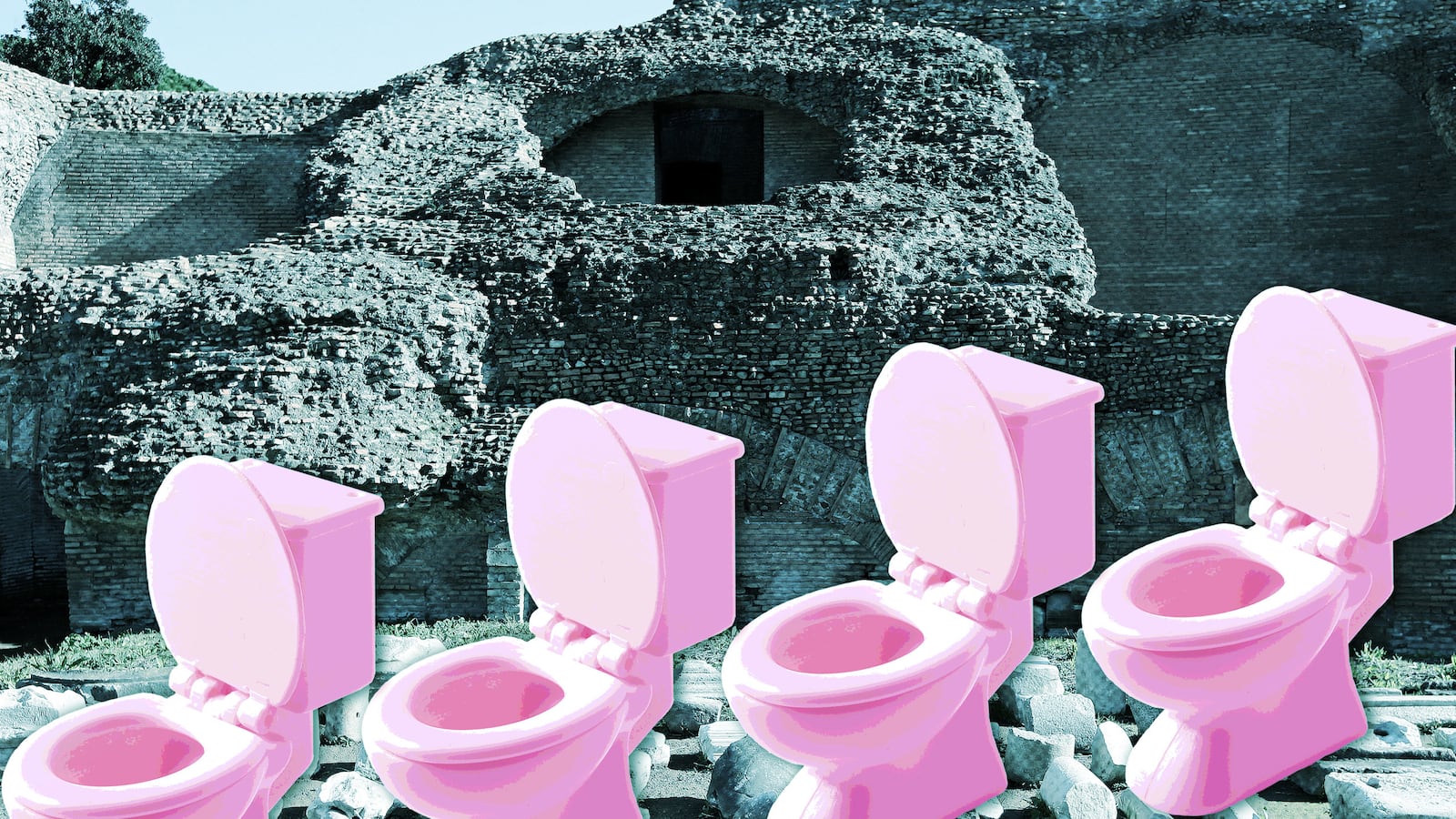When people think of Rome they think of the Coliseum, but this year the Coliseum has an ancient athletic rival: the Circus Maximus. After years of excavations and improvements, Rome’s charioteer stadium—the ancient equivalent of a NASCAR track—is finally open to the public. But however you feel about the races there’s plenty of interesting stuff to be seen here; the ancient world’s largest shopping mall, among them. But for my money one of the most interesting features is the well-preserved and very public ancient latrines, which operated with water siphoned from the nearby aqueduct. Bear with me. They’re a testament to Roman engineering and evidence that even though the Romans had a highly developed sense of decorum, they didn’t mind emptying their bowels en masse.
The multi-seat bathrooms (foricae) at the Circus Maximus are not unique; on the contrary, they existed all over the place. There is one at Ostia Antica, the ancient port of Rome; another at Ephesus in Turkey; another in Timgad, Algeria; and another at the emperor Hadrian’s second-century villa in Tivoli, Italy. They are everywhere. What they have in common is benches punctuated by keyhole-shaped openings that faced inwards and that usually sat about eight to twenty people. It seems that most people expected to do their business cheek-to-cheek.
Despite their proficiency with plumbing and engineering, the Romans did not invent the toilet. According to Cambridge archeologist Augusta McMahon, the first simple toilets were Mesopotamian pits, about 1 meter in diameter, over which users would squat. The pits were lined with hollow ceramic cylinders that prevented excrement from escaping. Approximately 1000 years later the Minoans invented the flush. The first flushing toilet, excavated at the palace of Knossos in Crete, washed waste from the toilet to the sewer. By the Hellenistic period large-scale public latrines brought toilets to the effluent masses.
Because of the public nature of the ancient bathroom they became sites for gossip and mockery. The emperor Tiberius actually banned people from carrying his image (on coins or rings) into the latrines. Archeologists have discovered games lodged between the seats, suggesting that there was social interaction between latrine users.
For the better off in society there was the possibility of some privacy. The ancient Jewish legal code the Mishnah refers to the existence of a lockable “latrine of dignity” in the Temple. And there appear to have been private toilets reserved for commanders at Roman forts. Hadrian’s villa, too, includes single-seater toilets, presumably for use by the emperor and those of high social status. As Gemma Jansen has argued, all of this suggests that bathroom privacy was a luxury for the wealthy.
Even though there’s plenty of evidence for socializing in ancient bathrooms, there’s some indication that Romans were anxious about going into latrines. The issue was not a question of sanitation (although some Roman bathroom graffiti instructs people “don’t shit here”), but safety. Bathroom business, like everything else in the ancient world, required divine protection from malevolent forces. Dr. Mary Jane Cuyler, assistant director of the University of Texas’s Ostia synagogue excavation, told The Daily Beast, “On one of my early visits to Ostia I was perplexed to discover an elaborate altar and shrine to the goddess Fortuna in one of the latrines in the firefighters’ barracks. At the time I thought it was a fluke, but I later learned that Fortuna is often associated with public latrines and with bathhouses.” She added, “This isn’t just something we know from the archaeological record. The Christian writer Clement of Alexandria actually mocks Romans for their practice of installing their greatest goddess in a latrine. He claims it’s a fitting temple for her!”
Clement may mock the Romans, but there seems to have been some legitimate cause for concern: it is likely that rats and other animals inhabited the Roman sewer and latrine system. And they would have posed a very real danger to men seated at latrine benches. Perhaps worshipping the goddess wasn’t a bad idea.
The evidence is ambiguous but one of the interesting features of most ancient and medieval bathrooms is that they generally do not appear to have been segregated by gender. Even though women were prohibited from participating in or entering many kinds of all-male spaces in the ancient world, the latrine wasn’t one of them.
In fact gender-segregated bathrooms were an innovation of the Victorian era, when they struck a blow for women’s rights. Up until the introduction of segregation in the nineteenth century, men had exclusive access to public restrooms. The result was that women were effectively tethered to their homes. While urinating over gutters or into “urinettes” (a small portable device that was used under long skirts and discretely emptied) were options, they were hardly preferred. Gender-segregated bathrooms, therefore, were actually a positive step. The 1887 Massachusetts law that mandated that workplaces provided bathrooms for female employees made it possible for women to hold down jobs without “holding it.”
The relatively recent history of gender-segregated bathrooms bubbled to the top of our consciousness in the wake of HB2, the North Carolina law that requires people use the bathrooms that correspond to the gender identified on their birth certificates A whole host of cultural commentators observed that gender-segregation was a relatively new phenomenon.The history of bathrooms is more interesting than one might imagine, giving us a view into class systems, gender politics, and (for those who want to do the digging) ancient diet. But if none of this is for you the Circus Maximus offers athletics, ancient shops, and, of course, brothels.





